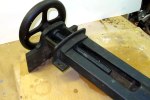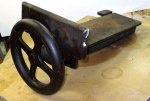
For much of the past week I have been traipsing around New England doing research and photography for the late-2014 book “Virtuoso: The Tool Cabinet and Workbench of Henry O. Studley.” More precisely, I was tracking down the four known bench vises with similarity to the two exquisite examples on Studley’s bench. (To understand fully the import of this trip, consider that 1) I dislike travel, 2) I was skirting blizzards the whole trip, and 3) my perception as a native of Flyover Country is that anything north and east of the Schuykill River is noted on maps with the warning, “Danger! Thar Bee Dragons”).
My first stop in this trek was at the home of famed ironmonger Patrick Leach, whose Blood & Gore site emits his monthly e-mail dose of vintage tool addiction. Most of you have parted with lucre in Patrick’s direction, and spending a few hours with him was an unmitigated pleasure. The workbench in his office holds two vises similar on the outside but distinct on the inside compared to Studley’s vises. One fascinating modification of Studley’s vises is the (retrofitted?) inclusion of a moving, housed dog on the end vise. Still, the similarities lead to some intriguing speculations.
Next I met with Tim Cottle for breakfast in southern Maine after he drove a couple of hours from his lair upstate. Tim acquired his vise in a swap with a neighbor who received four shop light fixtures in return. I offered to double his investment, but he declined with very little deliberation. Cottle’s vise is especially important to my inquiries as it is the only one of the six that is currently not attached to a bench, and Tim’s passion about the project led him to loan it to me for detailed study. The mechanism of his vise appears to be identical to Studley’s, and it only has one jaw, the movable one. I need to triple check very closely to make sure Studley’s vises are the same on my next visit later this month.
Finally, I spent some time in the well-organized shop of Dan Santos out on Cape Cod. He has a bench vaguely similar to Leach’s, with only the face vise remaining and the end vise missing. While the overall form and function are identical to the vises on Studley’s bench, there are some idiosyncrasies. The largest difference is the dovetailed ways for the moving carriage with the single jaw, with the rear unmovable jaw being a metal plate affixed to the bench. Santos’s vise is so finely tuned that a simple twist of the massive wagonwheel causes the jaw to move several inches simply on the inertia of the wheel, clamping a workpiece firmly based solely on that.
The vises in the aggregate are tantalizing, both for their similarities and their differences. It is clear that the general form was known in the piano-making trade, yet these are four distinct interpretations of that form. Admittedly, a sample set of six is hardly statistically valid, but they are 100 percent of the known iterations. They are all roughly the same size, they all have massive ~9 pound wagonwheels, they all have ~1 Acme-thread screws. Yet, four of the six have sliding platen/carriage construction, while two have round ways to guide the moving jaw. And the jaw profiles are not the same and the dimensions of the jaws – especially in thickness – vary widely, from about 1/2” thick to well over 1”.
Leach told me that Leominster, Mass., was once a thriving piano case-building city, and he speculates that these vises may have been built in the piano factories themselves based on a well-established form. It makes sense especially given the character of the wheels and screws, but given the number of piano factories producing astonishing numbers of pianos (c. 1900 it seems like nearly every household in America aspired to have a keyboard instrument of some kind) why are there only six of these beauties around? You would think that there would be more, many more. He recalls that the scrap metal drives of the two world wars melted down a lot of historic iron.
I became so impressed with the beauty and effortless precision of the vises on Studley’s workbench that I revised the book outline to include a chapter on them. Further, I have been fabricating foundry patterns for them and hope to have at least the patterns at Handworks in Amana, Iowa, and if I get lucky with time, perhaps an aluminum prototype. I also expect we will have Cottle’s vise at Amana. Eventually I will have a pair cast for me in bronze (except for the thread screw) and if the planets align, turn the patterns over to Jameel Abraham of Benchcrafted for manufacturing.
Over the weekend I was lecturing and teaching for the Society of American Period Furniture Makers’ New England Chapter and the Connecticut Valley School of Woodworking, including updates on the half dozen books I have in progress. Afterward, three attendees approached me with information about similar vises they either owned or knew about, and I invited them to send me pictures and written description and accounts. I extend the same invitation to you via the comments below.
Stay tuned.
— Don Williams


